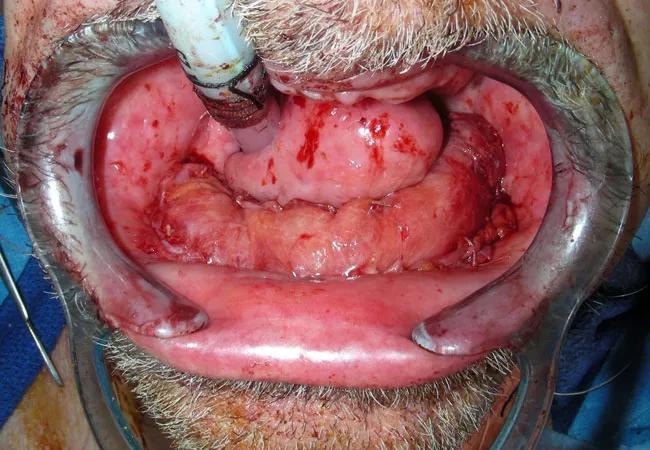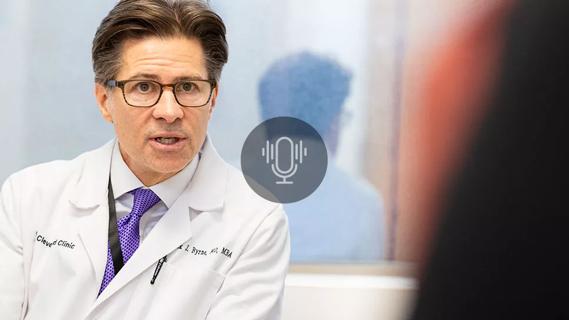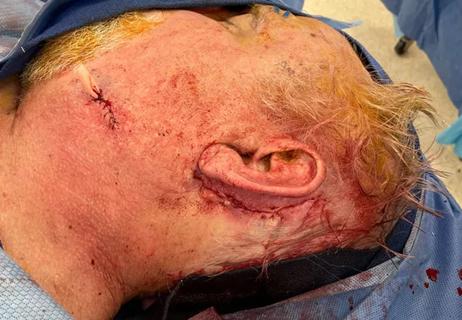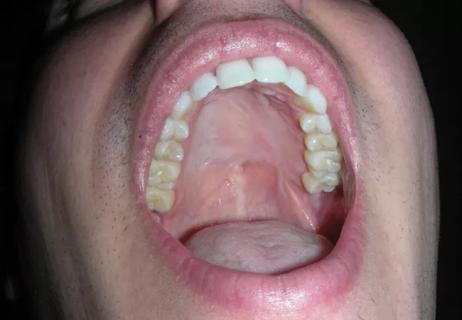Anterolateral thigh fascia flaps, minimal access approaches and abbreviated hospital stays are reducing the “costs” of free flap surgery

Written by Michael Fritz, MD
Advertisement
Cleveland Clinic is a non-profit academic medical center. Advertising on our site helps support our mission. We do not endorse non-Cleveland Clinic products or services. Policy
Free tissue transfer is among the most complex procedures performed in head and neck surgery, and it is typically associated with high morbidity treatment and protracted hospital stays. Advances in flap harvest and design, vessel isolation and postoperative patient management—all initiated here in Cleveland Clinic’s Head & Neck Institute—have dramatically changed this landscape.1-3 By combining the minimal morbidity of anterolateral thigh (ALT) perforator flap harvest technique with minimal access approaches for vessel procurement, a low morbidity free flap subset has been created. Patients undergoing these surgeries are commonly discharged within 72 hours and as early as the first postoperative day after surgery. This policy does not compromise flap success or increase postoperative complications or hospital readmissions.4,5 As a result, we have dramatically decreased the physical and financial “cost” of free flap surgery. Thus, indications for free tissue transfer have expanded both with regard to primary defect reconstruction and also for secondary procedures to improve quality of life, correct deformities or counter complications from previous oncologic treatment. Examples are as follows:
Defects in the palate may persist for a variety of reasons. These could be the result of unsuccessfully repaired congenital clefts, previous cancer or tumor removal, ischemic events (e.g., Wegener’s granulomatosis or cocaine use), trauma or infection. When locoregional tissue is compromised, or when primary reconstructive attempts fail, patients with fistulas have typically been relegated to management with long-term obturators. While these devices often provide tremendous relief to the speech and swallowing compromises created by palatal insufficiency, they require chronic maintenance, are prone to leakage and require manual dexterity for placement. As an alternative, using free vascularized fascia lata and vessels obtained through a 3 cm incision under the mandible, these defects can be repaired with near 100% reliability. Patients undergo a three- to four-hour operation and are typically discharged within two days after surgery.6
Advertisement
Osteoradionecrosis of the mandible, maxilla, skull base or cranium poses a frequent challenge for reconstructive surgeons. Typical management following bone debridement has included hyperbaric oxygen (HBO) therapy, despite controversy about the effectiveness of this costly and time-consuming treatment. However, if this initial course of action fails, there have been few options to stop disease progression. Using heavily vascularized fascia lata free flaps layered into oral bone defects, obliterating and covering areas of cranial exposure and draped onto debrided skull base bone, progression of bone destruction can be permanently halted. This method carries the advantage of a relatively short procedure with low morbidity, minimal edema, no risk of airway compromise and a 95% success rate in appropriate candidates. In a comparison study, the combined cost of rescue flap surgery and hospitalization was less than one-third the cost of HBO therapy. More importantly, this method does not compromise the ability to perform larger scale reconstruction, such as segmental mandibular repair, if necessary.7
Low morbidity fascia lata flaps can be applied to repair complex facial wounds following cancer resection. For example, one of the more challenging subsets of nasal reconstruction is large columellar and caudal septal defects. In the past, free tissue transfer was an infrequent consideration because of bulk, complexity and high morbidity. However, given the malleability and reliability of vascularized fascia lata, this flap can be applied to support new structural grafts and provide a foundation for skin grafts—using this method, rapid restoration of facial form and function can be achieved.8 Furthermore, when applied beneath the skin, these free flaps impart lasting and reliable correction of facial contour deformities, even in a previously irradiated or scarred milieu.9
Advertisement
Using low morbidity free flaps and vessel isolation techniques, the overall “cost” of free tissue transfer has decreased dramatically. This opens the opportunity for innovation to improve short- and long-term functional and aesthetic outcomes for our patients. Our ability to permanently transfer vascularity to compromised tissue with rapidity and high reliability suggests that early surgical intervention for osteoradionecrosis has merit to arrest this process and avoid long-term sequelae.
References
Advertisement
Advertisement

How innovations and advancements in skull base surgery are improving outcomes

The tri-vector gracilis procedure uses a thin muscle from the thigh to help create a natural mimetic smile

A high-level of expertise with a versatile technique is leading to reduced complications and easier post-operative recovery for patients

Cleveland Clinic's Hearing Implant Program’s minimalist approach to osseointegrated implants emphasizes an easy patient experience.

Reconstruction using minimal access approaches

Case study illustrates the potential of a dual-subspecialist approach

Evidence-based recommendations for balancing cancer control with quality of life

Study shows no negative impact for individuals with better contralateral ear performance